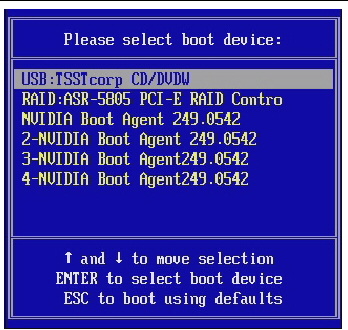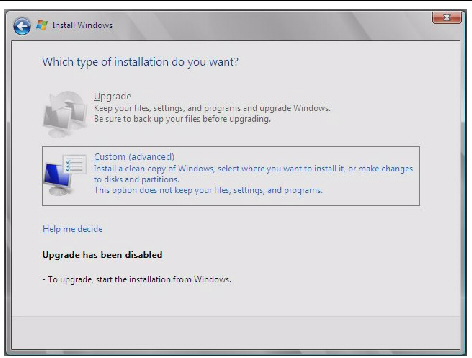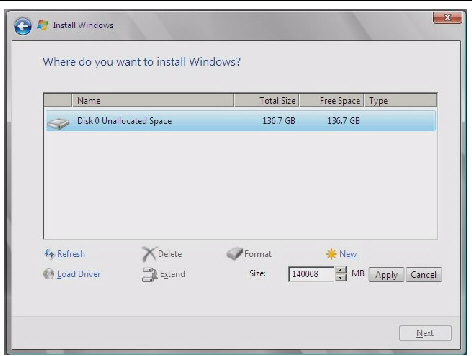Install Windows Server 2008
|
This chapter describes how to install the Windows Server 2008 operating system directly onto your server using the Windows Server 2008 media.
Installation Requirements
Before beginning the operating system installation, make sure that the following requirements are met.
For all installation methods:
- Complete the procedures in the previous chapters of this document that apply (Chapters 2 through 5).
- Verify that a keyboard and mouse are attached to the appropriate connections on your server. If you have a Sun Fire X4440 server, be sure to leave a USB port free if you selected the Floppy Disk Local mass storage drivers installation method.
- Make a note of the mass storage controller you received with your server. There are three possibilities, depending on your server:
- LSI-based integrated RAID controller (you will see a banner for this displayed during POST)
- Adaptec-based integrated RAID controller (you will see a banner for this displayed during POST)
- NVIDIA-based integrated disk controller (you will not see any banner for this displayed during POST)
- If your server uses an LSI-based integrated RAID controller and you want to include your boot drive as part of a RAID configuration, you will need to configure a RAID volume(s) using the controller’s BIOS configuration utility (accessible by pressing Ctrl+C when prompted during server boot) before you install the Windows operating system.
- If your server uses an Adaptec-based integrated RAID controller, choose one of the following installation options that best matches your needs:
- If you want to include your boot disk as part of a RAID configuration, you must configure your RAID volume(s) using the controller’s array configuration utility before you install the Windows operating system. The controller’s BIOS configuration utility is accessible during the server boot process by pressing Ctrl+A when prompted.
- If you have a clean boot disk (no partitions) and do not want to make it part of a RAID, you must still create an array volume on it using the controller’s BIOS configuration utility (accessible by pressing Ctrl+A when prompted during server boot) in order for Windows to be able to access the disk. This must be done before you install the Windows operating system. For more information, see Appendix B.
- If you have a disk with a preinstalled bootable array volume (and it is not part of an existing RAID that you want to keep) and you want to overwrite it to install Windows, no other disk preparation is required. During the Windows operating system installation you will be presented the option to overwrite any existing partition(s) within the array volume. The following figure shows an example of a system with an existing bootable array volume.
FIGURE 7-1 Example Startup Screen Showing Existing Adaptec-based Array Volume

- For information about specific details of the operating system installation, refer to your Microsoft Windows documentation.
| Note - The complete Microsoft Windows operating system installation process is not documented in this section. This section documents only the steps that are specific for installing Windows Server 2008 on your server.
|
For requirements specific to the mass storage driver and Windows media delivery methods that you have chosen, see TABLE 7-1.
TABLE 7-1 Requirements for Each Installation Method
|
Method
|
Action or items required
|
|
Floppy Disk Local (X4440 only)
|
Insert the mass-storage drivers floppy disk into a USB floppy drive attached directly to one of the server’s USB ports. Note that if you are using the floppy disk local installation method, the JavaRConsole floppy drive or floppy image devices must not be redirected.
|
|
Floppy Disk Remote (X4440 only)
|
Connect the floppy drive to the JavaRConsole system (if necessary) and insert the mass-storage drivers floppy disk into the floppy drive.
|
|
Floppy Image (X4440 only)
|
Ensure that the floppy.img file is accessible from the JavaRConsole system.
|
|
Windows Local
|
Make sure that the Microsoft Windows Server 2008 installation media and a DVD-ROM drive are available.
|
|
Windows Remote
|
Insert the Microsoft Windows Server 2008 installation media into the JavaRConsole system’s CD or DVD-ROM drive.
|
|
Windows Image
|
Ensure that the Windows Server 2008 installation media is accessible from the JavaRConsole system.
|
Installing the Operating System
Follow these steps to install the Microsoft Windows Server 2008 software onto your your server.
| Note - The Solaris Operating System may be preinstalled on your server’s boot disk. The Windows installation will format the boot disk and all data will be lost.
|
1. Make sure that you have completed all of the requirements listed in Installation Requirements.
2. Power cycle your server.
The BIOS POST process begins.
3. Press F8 when the Press F8 for BBS POPUP prompt appears on the BIOS POST screen (see FIGURE 7-2).
The BBS POPUP menu will allow you to select a boot device.
FIGURE 7-2 F8 Prompt Example

4. Once the BIOS POST process is complete, the Boot Device menu appears (see FIGURE 7-3). If you have selected the Windows Local installation method, insert the Windows media DVD in the server’s DVD drive now.
FIGURE 7-3 Boot Device Menu Example

5. Select CD/DVDW from the Boot Device menu and press Enter.
If prompted with Press any key to boot from CD, quickly press any key.
6. The Windows installation wizard starts. Proceed through the installation wizard until you see the Installation Type page displayed, and then click Custom (advanced).
FIGURE 7-4 Select Installation Type Page

7. You will then see the Where Do You Want to Install Windows page (see FIGURE 7-5), do one of the following:
FIGURE 7-5 Where to Install Windows Page Example

- If you are not installing Windows on a Sun Fire X4440, skip to Step 8.
- If you are installing Windows on a Sun Fire X4440, do the following:
i. Click the Load Driver option.
The Load Driver page is displayed.
FIGURE 7-6 Browse to Driver Media

ii. Click OK.
Make sure that the mass storage drivers are accessible according to the mass storage driver installation method that you selected in Chapter 3.
- Floppy Disk Local: Mass storage drivers on a floppy disk in floppy drive A on the server.
- Floppy Disk Remote: Mass storage drivers on a floppy disk in a floppy drive mounted as a device from the JavaRConsole system.
- Floppy Image: floppy.img file mounted as a device from the JavaRConsole system.
- Non-floppy media: Mass storage drivers on USB flash drive or CD/DVD plugged into the server or mounted as a device from the JavaRConsole system.
iii. Click the Browse button and navigate to the driver media folder.
FIGURE 7-7 Brows for Folder Screen Example

iv. Select the appropriate driver for your Adaptec-based integrated RAID controller (either the 32-bit version in the i386 folder, or the 64-bit version in the amd64 folder):
Sun STK RAID INT
v. Click OK.
The Select the Driver to Be Installed page is displayed with the selected driver.
FIGURE 7-8 Selected Driver Page Example

vi. Click Next.
The Where Do You Want to Install Windows page is displayed (see FIGURE 7-5). Proceed to the next step.
8. Do one of the following:
- If you do not want to override the Windows Default partition information, skip to Step 10.
- If you do want to override the Windows default partition information, click the Driver Options (advanced) option and proceed to the next step.

|
Caution - Formatting or re-partitioning a pre-existing partition will destroy all data on the partition.
|
9. At the Advanced Driver Options page (see FIGURE 7-9), do the following:
FIGURE 7-9 Windows Partition Management Page

a. Click Delete to delete the existing partition.
b. Click New to create the new partition.
c. Change size settings as needed, and then click Apply.
d. Click Next and proceed to the next step.
10. The Windows installation begins.
The server will reboot multiple times during the installation process.
11. When Windows installation is complete, Windows starts and prompts you to change the user password. Click OK and proceed to setup the initial user login account.
| Note - Windows 2008 enforces stronger password schemes for user accounts. Password standards include restrictions on length, complexity and history. If you need more details, click the Accessibility link at the account creation page.
|
Once the initial user account is created, the Windows Server 2008 desktop is displayed.
12. Proceed to Chapter 8 “Updating the Critical Server-Specific Drivers” to install server-specific software and the latest Sun-supported drivers.
| Sun Fire X4140, X4240 and X4440 Servers Windows Operating System Installation Guide
|
820-2399-13
|
   
|
Copyright © 2009 Sun Microsystems, Inc. All rights reserved.









